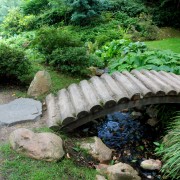Japanese garden design is based on certain principles related to balance and natural beauty, making it a popular choice.
This design works well in large landscapes as well as a city dweller’s small backyard or terrace. Size does not matter, as tranquility can be achieved in any space.
What is a Japanese garden?
In Japan, gardens are viewed as a separate world, a place for contemplation. They are to be experienced. Entering into a garden through a gate or walkway is a symbolic point where you leave your cares behind, and embrace the natural beauty within.
Here are a few guiding principles to incorporate in any Japanese garden design:
Mystery
Like other Eastern philosophies, Japanese design is filled with symbolism. “Without nothing, you cannot have something.” To the Japanese mind, there is beauty in what is absent as well as in what is present. The space between allows for contemplation and invites clarity. Japanese design appreciates the element of surprise, and uses subtleties to create mystery.
TIP: Consider different viewpoints with each area of your garden and take everything into consideration when designing your garden. Add hidden corners, paths that weave and bend or shadowed areas that encourage discovery. Provide seating to encourage contemplation.
Harmony
This principle states that beauty does not need to be contrived or overstated. Few ornaments are found in Japanese gardens. Architectural accents are used only when a point of visual interest is necessary to the overall design. For example, lanterns are still a common décor feature, but were initially a necessity for light.
A western eye might identify asymmetry as imbalance, but the Japanese find perfection here. Opposing forces come together in natural unity that represents the yin and yang of each element. A Japanese garden embraces the organic asymmetry of nature through carefully planned placement of rocks, sand, water, trees, flowers and even bridges.
TIP: Aim for uneven numbers like three or five when grouping rocks. Consider matching plantings in colour and placement, but contrasting in size or shape.
Natural unity
Rock and water are primary features full of symbolism in a Japanese gardening design. Rock size, composition and placement are all essential to their meaning. They can be used to represent mountains, heaven and even people. Specific stones can have meaning -- a wider stone set across the path might encourage one to pause and take in the view. Sand or gravel can be used to represent water.
Water appears in a natural context in the form of basins, ponds or streams. The flow of water in a stream or small cascade represents the relentless passage of time.
Japanese gardens provide beauty in every season. Plantings are selected based on their ability to be shaped and to demonstrate the changing seasons. Evergreens and shrubs, ferns, bamboo and other decorative grasses provide varied textures and shades of green.
TIP: Emphasize rock and water placement first. Add plantings last and use sparingly. Mix textures and colours.
A Japanese garden design should invite a sense of active calm.








